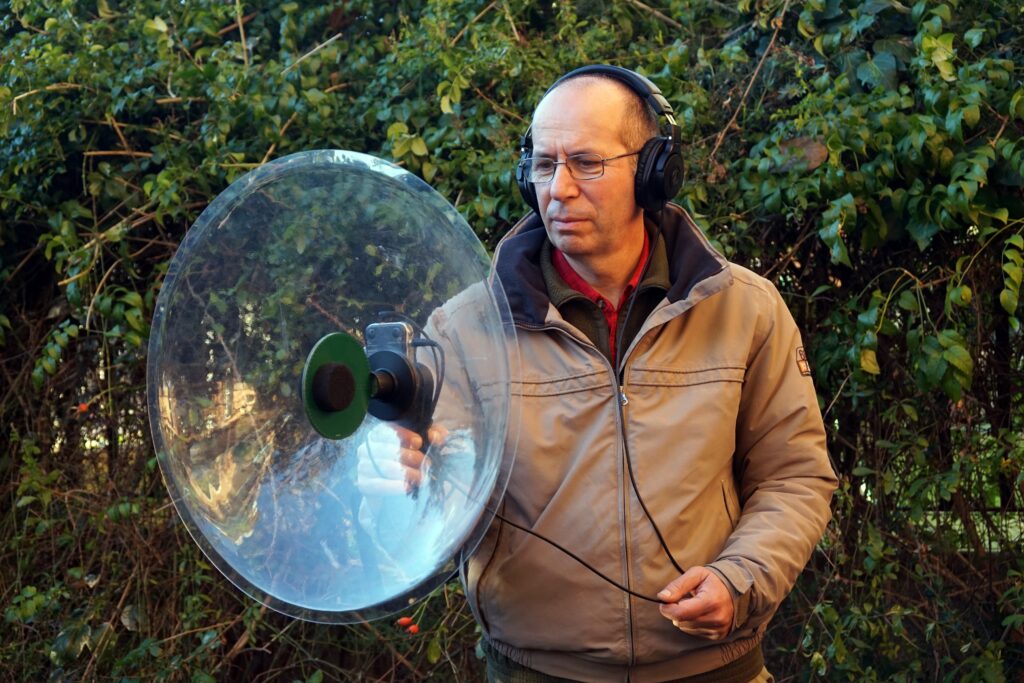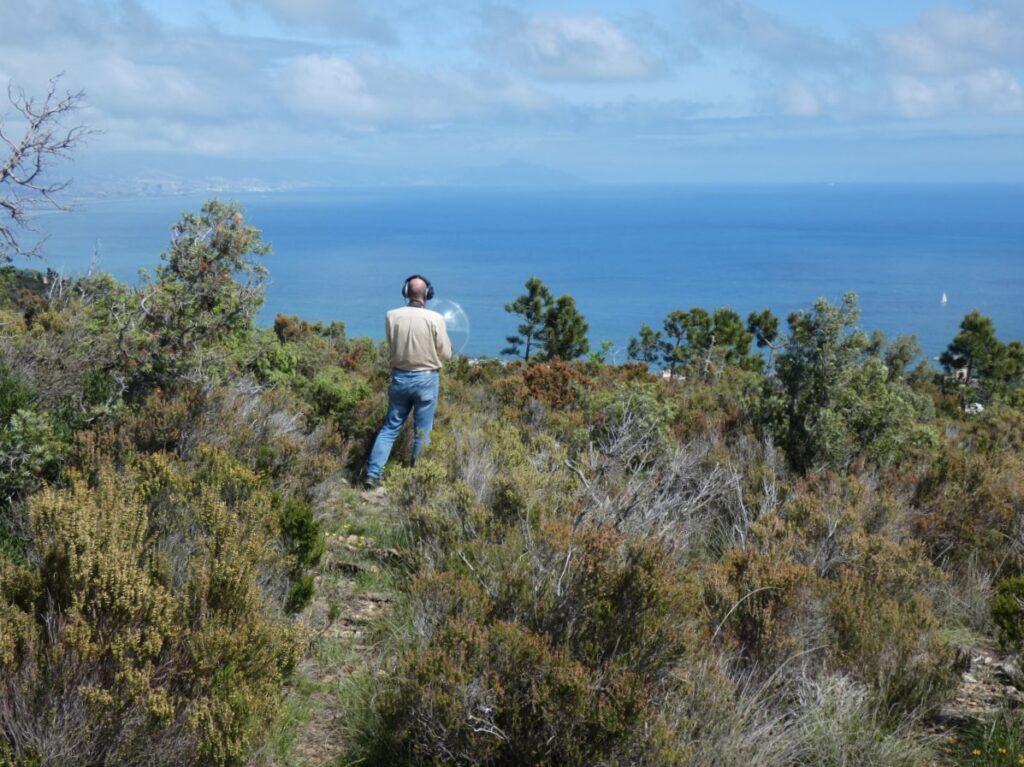LUCA BAGHINO
Reading Time: 6 minutes
Luca Baghino – at work with a stereo Hi-Sound and a Sony M10 recorder
Luca Baghino, 57 yo, from Genoa, has interest in birds for over forty years, with particular reference to the birds of Liguria, his native region.
He deals with ornithological studies and surveys and is a consultant for public and private entities. He has devoted many years to the study of the raptor migration at the west of Genoa, but also takes part in standardized censuses of breeding birds.
He has collaborated for differents initiatives and projects with the national LIPU (Italian Bird Protection League) since the ‘90s.
Among various scientific publications, he is the author of various ornitholigical papers and coauthored the book “The Short-toed Snake eagle – Biology and migration in the Ligurian Apennines”.
Today we have a chat with him to learn more about his activities in the acoustic field
Luca, can you tell us how you started?
Like many other people, in the second half of the seventies, I began to be interested in bird sounds as a necessary complement to the visual part, chiefly aimed to the field identification. Of course at the time (I was a boy …) people traveled with modest cassette recorders and for training purposes we had available cassettes or vinyl records to learn voices and songs … another world compared to today in terms of technology. But that was a first knowledge and was useful, for example, for making surveys such as the Atlas Project of breeding birds in Liguria
And more recently?
Well, my activity on the field has continued for years with standardized surveys and projects such as MITO-FBI and others in Liguria where aural identification always was essential. But later and now at a mature age, perhaps a random occurrence led to develop my interest in the fascinating world of animal sounds more deeply than before. In 2013 I had to chance to pick an Eastern Bonelli’s Warbler Phylloscopus orientalis having a migratory rest in a place that I knew like the back of my hand; the particular contact call of that bird of a rare and irregular species (I had never seen it before, and later) made me realize that there was something strange, then I saw and identified it among the tree canopy: I heard it calling while I was indoors, just to say …
What consequence did this meeting have?
Well I don’t know if as a direct effect of that chance encounter or as an evolution of my “personal path” from 2015 I also took a deeper interest in recording, and I dedicated myself to the topic of flight calls at night (the so-called NFC -ndr Night Fight Calls-). In late spring/early summer, at peak of the bird song season, whenever possible, I prefer recording with the use of parabolas.
What gear do you use?
I have several 96kHz / 24bit recorders: among them, the excellent Sony PCM-M10 is my favorite when coupling with the parabolic microphones: it is small and compact, but is truly outstanding.. However, I also use the old version Zoom H1 a lot: this has always fully satisfied me, this being a real workhorse and all round recorder. I recently got a second-hand Tascam DR-100 mk III, a very high quality recorder that I would like to use mostly in specific situations. I am testing it just in these days to evaluate the best matches with the different external mics I own. As for the headphones, I have a pair of Audio Technica ATH-M30x and Sennheiser HD 25 closed headphones. I have been using Adobe Audition 3.01 as my audio editing software for years
What about of the microphones instead?
I have a few dishes of different diameters, all of the stereo type for now. The first and most used so far is the Dodotronic Hi Sound stereo, another workhorse that has given me so much. I also used extensively the Primo EM 172s for some DIY applications, both on rigid support and embedded, also following some previous experiences of yours. The Primo really are great capsules for naturalistic use and more. I do not use shotgun microphones instead: as I am so used to the isolation and the amplifying power of the dish, so far I did not get along very well this kind of mics.
Have you been interested in other aspects of animal recording over the years?
Yes, thanks also to your requests, I delighted in acquiring sounds from other animal groups. With the help of the excellent Ultramic 384K from Dodotronic I obtained interesting information and presence data on bats. I also happened to make some recording of Orthoptera, both in an intentional or “involuntary” way, obtaining a few elements that I think are intriguing. It is the universe of animal sound and communication that is fascinating for its complexity, adaptation and variability; also the technical aspects, the exercise and the practical experience aimed at improving the recording sessions are however essential and no doubt important.
Below are some recordings by Luca Baghino
__________________________________________________________

Italian version
Luca Baghino 57 anni, di Genova, da oltre quarant’anni si interessa di avifauna con particolare riferimento a quella ligure.
Si occupa di studi e rilevamenti ornitologici ed è consulente per enti pubblici e privati. Ha dedicato molti anni allo studio della migrazione dei rapaci nel Ponente genovese, ma anche ai censimenti dell’avifauna nidificante.
Ha collaborato per varie iniziative e progetti con la LIPU (Lega Italiana Protezione Uccelli) nazionale fin dagli anni Novanta.
E’ autore, tra le diverse pubblicazioni scientifiche, di vari articoli e del libro “Il Biancone – Biologia e migrazione nell’Appennino ligure”.
Oggi facciamo due chiacchiere con lui per conoscerne anche l’attività in campo acustico
Luca, ci racconti come hai iniziato?
Al pari di tanti altri ho cominciato, nella seconda metà degli anni Settanta, ad interessarmi al mondo delle vocalizzazioni degli uccelli come necessario complemento alla parte osservativa ai fini dell’identificazione sul campo. Certo all’epoca (ero ragazzo…) si viaggiava con modesti registratori a cassette e per la parte formativa esistevano musicassette o dischi vinilici per apprendere voci e canti… un altro mondo rispetto ad oggi in fatto di tecnologie. Ma fu un primo bagaglio conoscitivo utile, ad esempio, per i primi rilevamenti del Progetto Atlante degli uccelli nidificanti in Liguria
Più di recente?
Beh l’attività sul campo è seguita per anni con i rilevamenti standardizzati per progetti quali MITO-FBI e altri in Liguria dove il riconoscimento uditivo era essenziale. Poi però, ormai in età matura, forse un evento casuale mi ha portato a sviluppare più in profondità l’interesse per l’affascinante mondo delle sonorità animali. Nel 2013 incocciai in un individuo di Luì bianco orientale in sosta migratoria in una località che conoscevo come le mie tasche e il particolare verso di contatto di quell’individuo di una specie rara e irregolare (non l’avevo mai vista prima) mi fece realizzare che c’era qualcosa di strano, individuandolo poi tra la vegetazione: lo sentii mentre mi trovavo al chiuso, per dire…
Che conseguenza ha avuto questo incontro?
Beh non so se per effetto diretto di quella segnalazione o come evoluzione di un mio “percorso personale” dal 2015 ho preso anche ad interessarmi alla registrazione dedicandomi all’ambito dei richiami di volo di notte (i cosiddetti NFC –ndr Night Fight Calls-). In primavera estate, nel pieno della stagione canora degli uccelli, quando possibile, prediligo la registrazione con uso di parabole.
Che attrezzature usi?
Ho diversi recorder 96kHz/24bit tra i quali il mio preferito per l’accoppiamento con i microfoni parabolici è l’eccellente Sony PCM-M10: è piccolo e compatto, ma è superlativo. Uso però molto anche lo Zoom H1 vecchia versione che mi ha sempre pienamente soddisfatto, un vero cavallo di battaglia, per tutte le situazioni in cui serve. Ho di recente preso un Tascam DR-100 mk III d’occasione, un prodotto di qualità molto elevata che punto ad utilizzare in particolari situazioni. Lo sto testando in questo periodo in modo da valutare le migliori combinazioni con i vari microfoni esterni in mio possesso. Per le cuffie ho un paio di cuffie chiuse Audio Technica ATH-M30x e Sennheiser HD 25. Uso poi da anni Adobe Audition 3.01 come software di editing audio.
Sul fronte dei microfoni invece?
Ho diverse parabole, di differente diametro, per ora tutte stereo. La prima e la più usata finora è la Dodotronic Hi Sound stereo, altro cavallo di battaglia che mi ha dato tanto. Ho anche ampiamente utilizzato le Primo EM 172 per alcune realizzazioni DIY, sia su supporto rigido, sia libere ma incastonate, seguendo anche le tue precedenti esperienze. Le Primo sono capsule davvero eccellenti per l’uso naturalistico e non solo. Non adopero invece microfoni tipo shotgun: abituato alla capacità di isolamento e amplificazione della parabola, finora non mi sono trovato molto bene con questo tipo di strumenti.
Ti sei interessato ad altri aspetti della registrazione animale negli anni?
Si, anche grazie ai tuoi stimoli, mi sono dilettato ad acquisire suoni di altri gruppi animali. Con l’aiuto dell’eccellente Ultramic 384K della Dodotronic ho ottenuto informazioni e dati di presenza anche interessanti sui Chirotteri. Mi è capitato di fare qualcosa anche con gli Ortotteri, in forma intenzionale o “involontaria” ottenendo anche qui alcuni elementi secondo me interessanti. È il mondo della comunicazione sonora degli animali ad essere affascinante per la sua complessità, per gli adattamenti e le variabilità; anche l’aspetto tecnico, l’esercizio e l’esperienza pratica volte a migliorare le sessioni di registrazione sono però imprescindibili e chiaramente importanti.

Commenti recenti